Home Preparedness
Having grown up in SoCal earthquake country, I have a lifelong relationship with seismic activity. And having committed to a geology degree, I am deeply fascinated by the dynamics of earth’s moving surfaces.
We live in an amazing place — on an island that is not done forming (as we learned all too well this week in the middle of the night). The Pacific Northwest Seismic Network posted this to share their interpretation of the recent “earthquake swarm”.

Data and image courtesy PNSN.
Bainbridge Island presents one of the most unique sites in the world to teach plate tectonics to 7th graders, as I once did with a “field mapping trip” to both ends of the island. While most island beaches are composed of loose sandy/rocky material left behind by melting glaciers at the end of the last ice age (~17,000 years ago), beaches south of the Seattle Fault Zone are solid bedrock, 30 million years in the making through complex geologic activity that occurs at some tectonic plate boundaries.
The beauty of Earth slowly transforming its kinetic energy into a great amount of potential energy can make life ugly for people when it is instantly released in its natural cycle. And our 2 types of beaches are a direct result of the type of landform where that energy is released—a fault line. Life on Bainbridge Island after such an event will be inherently challenging for a number of reasons.
At risk of being a Debbie Downer, I want to encourage you to click on some of the resources below and take action so your family is prepared in case of such an event. This information is in the best interest of your household to be aware of.

The following excerpt is from the City of Bainbridge Island’s Emergency Preparedness webpage.
“Reality Check - Life on Bainbridge Island after a Major Earthquake
During a disaster, resources are allocated to areas where they can do the most good for the largest number of people. We will be competing for these resources and it's very likely we will be a low priority in comparison to larger metropolitan areas such as Seattle and Tacoma.
- Resources on the island will be limited and emergency response teams will be dispatched where they can do the most good for the greatest number of people.
- The Agate Pass bridge may be down, or closed for an extended period of time until its structural integrity can be assured.
- Ferry service may be stopped, or closed to the public for an extended period of time; the dock and other WSF facilities may be damaged, further complicating the situation.
- You may be separated from your family for an extended period of time.
- You, or a member of your family, might be seriously injured. The casualty count will be high - hundreds to thousands injured. Accessibility to medical care, supplies and treatment options will be limited.
- Electricity, phone, water/sewer systems will be out of service for an extended period of time. Wells and septic systems may be damaged and out of service as well. Waste/refuse disposal services may be stopped.
- Extensive, widespread damage to infrastructure, residential, commercial and government buildings. Many structures will be uninhabitable and emergency shelters will be overwhelmed.
- No gasoline or propane available for an extended period of time.
- Grocery/restaurants/businesses closed for an extended period of time; food supplies and cash will be hard to come by.
- Civil unrest is possible.
- There will be a large number of fatalities.
Are you and your family ready for this? What if the disaster were a pandemic or a chemical, biological, radiological or nuclear (CBRN) event and you had to shelter in place for a week or longer? Do you have the supplies on hand to sustain your household for an extended period of time?”
RESOURCES:
Seattle Times: Get Ready to Rumble: A Guide to Earthquake Preparedness
Red Cross: Be Red Cross Ready
Washington State Emergency Management: Map Your Neighborhood
